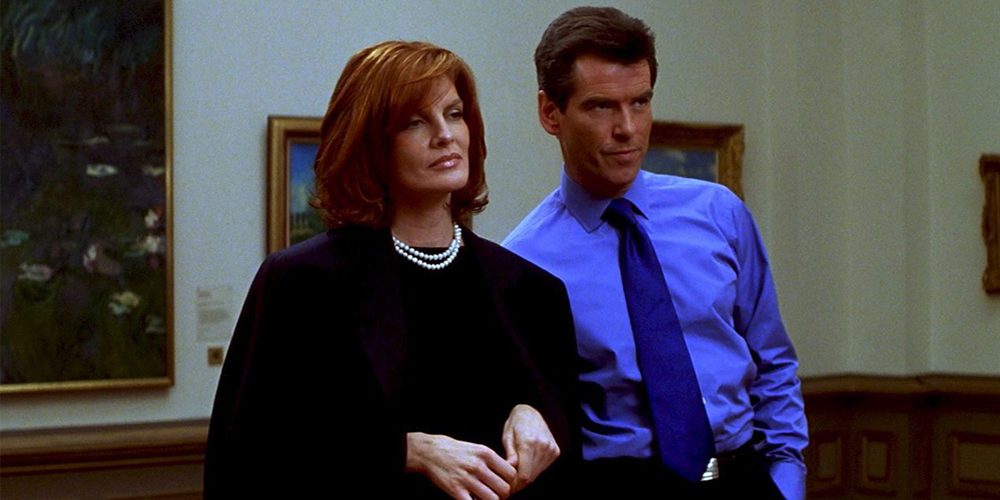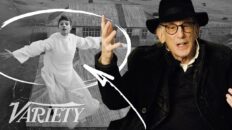“Has it occurred to you that you have a problem with trust?”
“I trust myself implicitly.”
“Yes, but can other people trust you?”
“You mean society at large?”
“I mean women, Mr. Crown.”
“Yes, a woman could trust me.”
“Good. Under what extraordinary circumstances would you allow that to happen?”
“A woman could trust me as long as her interests didn’t run too contrary to my own.”
“And society at large? If its interests were to run counter to your own?”
The question hangs in the air. The film will provide Crown’s answer, as signaled by the way title card bursts onto the screen and Conti’s score erupts into a full statement. Thus the film neatly introduces and accentuates its overlapping conflicts: man versus woman and man versus society. The primary battlefield for both of these conflicts will be the Metropolitan Museum of Art.
Art was not among the chief concerns of the original 1968 Norman Jewison film, in which the extravagantly wealthy Thomas Crown seeks to dispel midlife malaise by orchestrating an elaborate bank robbery. Crown functions as a kind of trickster god, inhabiting a world so detached from the concerns of everyday human life that it might as well be Olympus. Like Zeus, Crown meddles in the lives of ordinary people for his own amusement. Also, like Zeus, he proves highly susceptible to desire, and subsequently becomes entangled with insurance investigator Vicki Anderson, who has been assigned to the task of exposing his involvement in the crime.
The 1968 film consists almost entirely of texture, from its magnificent fashion to its ostentatious split-screen collages to Michel LeGrand’s sumptuously breezy score (which gifted the world with “The Windmills of Your Mind”). The film’s only anchor is the allure and chemistry of its two leads. Given that McQueen and Dunaway were both at the height of their star power when they appeared in the film, that chemistry is not inconsiderable. But, for all of its panache, Thomas Crown ’68 remains somewhat intangible. Reach out to touch it and it turns to pleasantly scented mist.
Director John McTiernan’s 1999 remake of The Thomas Crown Affair revisits the original’s essential premise—a billionaire with a midlife crisis orchestrates an extravagant theft and becomes infatuated with the woman investigating the crime—but is ultimately a more robust confection. Among its many alterations to the original’s template, the most significant is that the ‘99 film shifts Crown’s target from a bank to a Monet painting that he secretly covets. Thus the film improves on the original’s essential stick-‘em-up theft by transforming the theft into a more personal expression of desire.
McTiernan’s film paints Crown as a man entrapped by his own life. His introductory scenes frame him in sparsely elegant skyscraper offices and board rooms and elevators, and in each of these spaces he’s always looking to be somewhere else. He’s weary of the big money business and its kind of warfare; while orchestrating a takeover of another company, Crown bemoans that they didn’t show “more grit.” The only place he seems comfortable is the Metropolitan Museum of Art, his new prey.
This Metropolitan Museum of Art extends from the elite society that Crown inhabits and resents. The museum may be a kind of public space, a repository of art for the eyes of the public, but it remains the case that to actually impact the art world, that world of cocktail receptions, galleries, auctions, and endowment, requires significant capital. It’s the difference between owning art and simply looking at it. Crown is the kind of person who owns it, and owns a lot of it.
As the film’s intricate initial heist unfolds, the film presents us with a tour group of children gazing at Monet’s “San Giorgio Maggiore at Dusk”—Crown’s target—with boredom. The tour guide tries, in vain, to stir the interest of the children with details about the Impressionist movement, until she tries another tack: she stops her spiel and announces that the Monet is worth a hundred million dollars. The children’s eyes light up. The painting is transfigured. Swirls of paint becomes an emblem of luxury.
Just a little earlier, when the film first places Crown in the same room as Monet’s “San Giorgio Maggiore at dusk,” Crown feigns disinterest in his intended target by fixating on a painting of haystacks. When he declares his indifference to the Monet, the museum attendant asks, in disbelief, whether Crown knows what it’s worth. Crown, of course, knows exactly what it’s worth, but money, for Crown, holds no mystique at all. Crown exists in a world in which everything is obtainable, where the only commodity left that matters is pleasure. In stealing the Monet, Crown functions as both art-lover and performance artist. The theft has no genuine material gain associated with it (beyond, as we find out, the construction of a “perfect” forgery of the Monet that Crown wants for his personal collection). Crown breaks the rules because breaking the rules is a challenge, and because, in doing so, he can declare his victory over the society he has come to resent.
Embedded into the ensuing investigation into Crown is a social class conflict between the working class detectives assigned to the case (played with humor by Denis Leary and Frankie Faison), who find themselves struggling to grasp the motivations behind the crime, and the cultured, wealthy persons who have a mutual understanding: Crown and insurance investigator Catherine Banning (Rene Russo). Appearing on the scene in extravagant style and a smarter-than-thou manner, Banning quickly recognizes the theft as “an elegant crime, done by an elegant person,” identifying Crown as the potential thief through of a cocktail of intuition and observation.
Crown and Banning, kindred spirits in sensibility and in background, rose up out of low-class origins, economic warriors who worked their way to the top only to find themselves marooned in the upper class. They both thrive on the tense game in which they find themselves, each daring the other to take new risks, and with each step entangling themselves further.
Accordingly, it’s important that this pair has chemistry, and they do, albeit of a more tangible kind than McQueen and Dunaway had in the original. If the film gives McTiernan ample room to flex his muscle, to build elegant extensions of the suspenseful set pieces that established his place as one of the great Hollywood craftsmen of the 80s and 90s, it also gives McTiernan freedom to play with the rhythms of dialogue-driven comedy. With his collaborators, cinematographer Tom Priestly and editor John Wright, he structures scenes of conversation around atypical angles and subtle camera shifts, staying with the faces of his performers long enough for them to develop complexity.
When cast as Thomas Crown, Pierce Brosnan was well into his tenure as James Bond, and his contract as Bond required that he never appear in full black tie attire. Accordingly, when The Thomas Crown Affair requires that Crown attend a black tie event, his tie is left undone, a bit of convention-defying sprezzatura that serves as an effective metaphor for Brosnan’s approach to Crown in general. Freed of the shackles of the Bond character, which always seemed to restrict Brosnan like a straitjacket, Brosnan seems at ease, more willing to indulge his natural gift for light comedy. Brosnan’s Crown feels tangible and human, a mastermind of sorts, but still capable of being thrown off-balance, of losing his way in the course of a conversation.
Given that Crown remains a cipher throughout—the structure of the film ensures that his intentions only fully come into view in the final scene—Rene Russo is tasked with being the film’s life-force, and she is more than up to the challenge. Russo has sadly never truly received her due as an actress, but she’s marvelous here, a radiant film presence and a careful dramatic interpreter. Russo manages to do so much when the script gives her very little, adding animation and color to exchanges and beats that would, in other hands, be relatively undistinguished. Like Brosnan’s Crown, Russo’s Banning often finds herself exasperated, fighting her way through the case’s complexity and Crown’s traps with grit but also endless amusement. If she ultimately succumbs to his charms, the film routinely suggests that she may be the stronger of the pair.
The film’s primary source of pleasure lies in witnessing these beautiful people in beautiful spaces fall for one another. The flippancy and freedom with which they enjoy art remains a signifier of their luxurious world. One especially charming moment finds them at an island getaway where they enjoy a battle of wills over a crated painting. Banning believes that crated painting might be the stolen Monet, and defiantly tosses it in a fire pit. Her face falls as she watches it burn, her initial confidence crumbling into uncertainty and doubt, believing that she may have actually destroyed a masterpiece. As it burns, it turns out to be a Renoir, which may or may not be a copy (Crown remains coy). Banning sighs and laughs, conceding defeat, “You’re not boring, I’ll give you that!” It’s a moment of light, but altogether extraordinary decadence, not unlike the apocryphal story about Cleopatra dissolving one of the largest pearls in the world in a glass of vinegar, drinking it for his amusement.
In this case, the spectacle is for the audience’s amusement in a story all about freedom. Crown’s dream, the one he pitches to Banning, is a dream of freedom: freedom from material want and the strictures of society. He offers her an escape to pleasure. It’s a fragile and futile dream, one the film acknowledges is scarcely like to succeed. Crown’s therapist, played with great relish by Faye Dunaway (appearing here as a nod to the original film), heaps scorn on his romantic ambitions, warning that he’s headed to an ultimate destination of nowhere. But it sure is pleasant while it lasts.
Crown and Banning’s relationship ultimately requires some kind of mutual trust to succeed, even if impermanently. Crown conceives of a grand final gambit: he promises to return the painting to the wall of the museum, freeing them both of the restrictions of the case, if she’ll make a display of faith and not inform the authorities of his intentions. The climax reveals that Crown’s promise was made with the understanding that he knew he’d be betrayed, and he returns the art in a spectacular act of performance art directed at Banning.
The heist sequence has always belonged to the cinema more than it has any other narrative art form, in part because no other narrative art form so neatly juggles perspectives and durations of time. But the heist sequences that bookend The Thomas Crown Affair are less about the procedural thrills of the standard-issue heist than they are about misdirection. They’re cinematic sleight-of-hand, magic tricks through which Crown defies both the in-movie obstacles and the expectations of the film’s audience.
In his greatest magic trick, Crown transforms into a living work of art. He steps into the Metropolitan Museum of Art dressed as Magritte’s “Son of Man,” a nod back to one of Banning’s remarks that the painting reminds her of Crown. As the authorities close in, Crown suddenly switches briefcase with a doppelgänger, and then that doppelgänger switches a briefcase with another, and in a matter of moments the entire Metropolitan Museum of Art is flooded with a flash mob of men dressed as the “Son of Man,” switching briefcases with abandon. Crown has multiplied himself, and Banning, his primary audience, laughs with delight, her feelings of shame at her own betrayal giving way to joy at the spectacular jest.
This delightful sequence—one apparently conceived by McTiernan himself—revels in the inadequacy of the police force to overcome Crown the stunt-artist. As Crown thwarts his pursuers, Conti’s score gives way to an integrated and embellished version of Nina Simone’s rendition of the great spiritual, “Sinnerman,” which challenges Crown to successfully evade the day of judgment. Crown reveals that he has been several steps ahead of the police all along: he never really stole the painting for more than a few days, and had returned the painting back to the museum in another form, disguising it as a Pissarro. In a gesture of personal pride, he signs his work, leaving behind pencils emblazoned with the name of his company, “Crown Acquisitions.” Not content to simply outwit his adversaries, Crown goes a step further; having returned a painting, Crown steals another. This time, he steals a painting that Banning admired.
Banning interprets Crown’s performance as an declaration of love and leaves to chase after Crown. Denis Leary’s detective, ever the philistine, renders his own verdict on Crown’s performance art as she prepares to depart: “If some Houdini wants to snatch a couple swirls of paint that are really only important to some very silly rich people, I don’t really give a damn.”
Crown has yet a few more tricks up his sleeve (the film plays out the bitter end of the original film and then flips it to offer a happy ending), but Banning gets the film’s last word. As the two sail off to their happy ending, she makes Crown a threat that refers back to Magritte’s “Son of Man.” In Magritte’s painting, the central figure has an arm bent-backwards. Banning warns Crown, the human incarnation of Magritte’s painting, that if he ever pulls a trick like that again, she’ll go further than Magritte: she’ll break both of his arms. Ah, l’amour.
Rumblings of a sequel followed in the year after its release, but the one that came closest to becoming a reality would have loosely adapted the film Topkapi as a new Thomas Crown adventure, with Paul Verhoeven taking over as director and Angelina Jolie rumored to be in talks as Crown’s new love interest. The screenplay for the unmade sequel offered at least one inspired moment, an introduction that allowed the audience to glimpse the end of Banning and Crown’s romance. While skydiving (adrenaline junkies to the end), Banning whispered something inaudible to Crown, then pulled the cord of her parachute, vanishing from the frame and from Crown’s life forever.
Alas, all things must end, but at least this affair would have ended the same way it began: with style.









